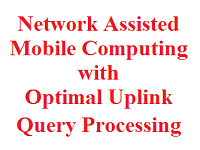Network Assisted Mobile Computing with Optimal Uplink Query Processing
Abstract:
Numerous portable applications recover content from remote servers by means of client created inquiries. Handling these questions are regularly required before the coveted substance can be recognized. Handling the demand on the cell phones can rapidly sap the restricted battery assets. Then again, preparing client inquiries at remote servers can have moderate reaction times due correspondence inertness brought about amid transmission of the possibly extensive inquiry. We assess a system helped versatile processing situation where mid-network hubs with “renting” capacities are sent by a specialist co-op. Renting calculation power can lessen battery use on the cell phones and enhance reaction times. Nonetheless, acquiring preparing power from mid-arrange hubs comes at a renting cost which must be represented when settling on the choice of where handling ought to happen. We contemplate the tradeoff between battery utilization, preparing and transmission idleness, and mid-organize renting. We utilize the dynamic programming structure to fathom for the ideal handling approaches that recommend the measure of preparing to be done at each mid-arrange hub with a specific end goal to limit the handling and correspondence dormancy and handling costs. Through numerical examinations, we look at the properties of the ideal preparing approach and the center tradeoffs in such frameworks.
Algorithm: Novel Routing Algorithm
Existing System:
In the past segment, we recognized exceptional properties of the ideal handling strategy under different situations. We now look at some of these properties through numerical examinations with illustration cost capacities and frameworks. Inertness, battery use, and renting costs have a firmly woven relationship.
Impediments:
i. Increasing battery utilization will diminish inactivity and renting costs, yet in addition confines the lifetime of the cell phone.
ii. Conversely, the lifetime of the gadget can be stretched out by expanding renting costs which will diminish inertness and battery utilization.
Proposed System:
A client asks for begins at the Mobile Station (MS). Keeping in mind the end goal to be finished, the demand must be transmitted upstream to a remote Application Server (AS) by means of a Base Station (BS) and a progression of transfer hubs. We allude to the hub at the main jump as the base station, however, stress that the connections between the BS, transfer hubs, and AS might be wired or remote. Thus running a content to discourse change application for use situations.
Points of interest:
i. If the demand preparing is altogether done at the MS, the restricted battery power can be depleted.
ii. If the preparing is done at the AS, correspondence inertness can be high because of restricted data transfer capacity of the remote access connection and vast question estimate.
Modules:
1. Leasing Model
2. Relaying Strategies
• Amplify-and-forward
• Decode-and-forward
3. Multi-bounce Transmission
Renting Model:
Using the handling energy of middle person hubs is the primary thought behind Network-Assisted Mobile Computing. Renting handling power from mid-organize hubs can be to a great degree valuable to lessen inactivity and to expand the battery life of a cell phone. In any case, it accompanies a cost. These expenses can catch the charge required to rent CPU control from the mid-organize hubs. Moreover, these expenses may catch potential security hazards by giving access to customer information to these hubs. A few tasks, for example, transcoding, should be possible on
Encoded information, while other would require unscrambling the information. The versatile station sends one sentence for ex: (how are you), in the application server get the sentence into sound.
Transferring Strategies:
• Amplify-and-forward
• Decode-and-forward
In open up and-forward, the transfer hubs basically help the vitality of the flag got from the sender and retransmit it to the beneficiary. In decipher and-forward, the hand-off hubs will perform physical-layer interpreting and afterward forward the disentangling result to the goals. On the off chance that different hubs are accessible for collaboration, their radio wires can utilize a space-time code for transmitting the hand-off signs. It is demonstrated that collaboration at the physical layer can accomplish full levels of decent variety as a framework, and thus can lessen the impedance and increment the availability of remote systems.
Multi-jump Transmission:
Multi-jump transmission can be represented utilizing two-bounce transmission. At the point when the two-jump transmission is utilized, two schedule vacancies are expended. In the principal space, messages are transmitted from the portable station to the hand-off, and the messages will be sent to the Application Server in the second opening. The blackout limit of this two-jump transmission can be inferred thinking about the blackout of each bounce transmission.
HARDWARE REQUIREMENTS:
• System: Pentium IV 2.4 GHz.
• Hard Disk: 40 GB.
• Floppy Drive: 1.44 Mb.
• Monitor: 15 VGA Color.
• Mouse: Logitech.
• Ram: 512 MB.
SOFTWARE REQUIREMENTS:
• Operating framework: Windows XP Professional.
• Coding Language: C#.NET
Download: Network Assisted Mobile Computing with



